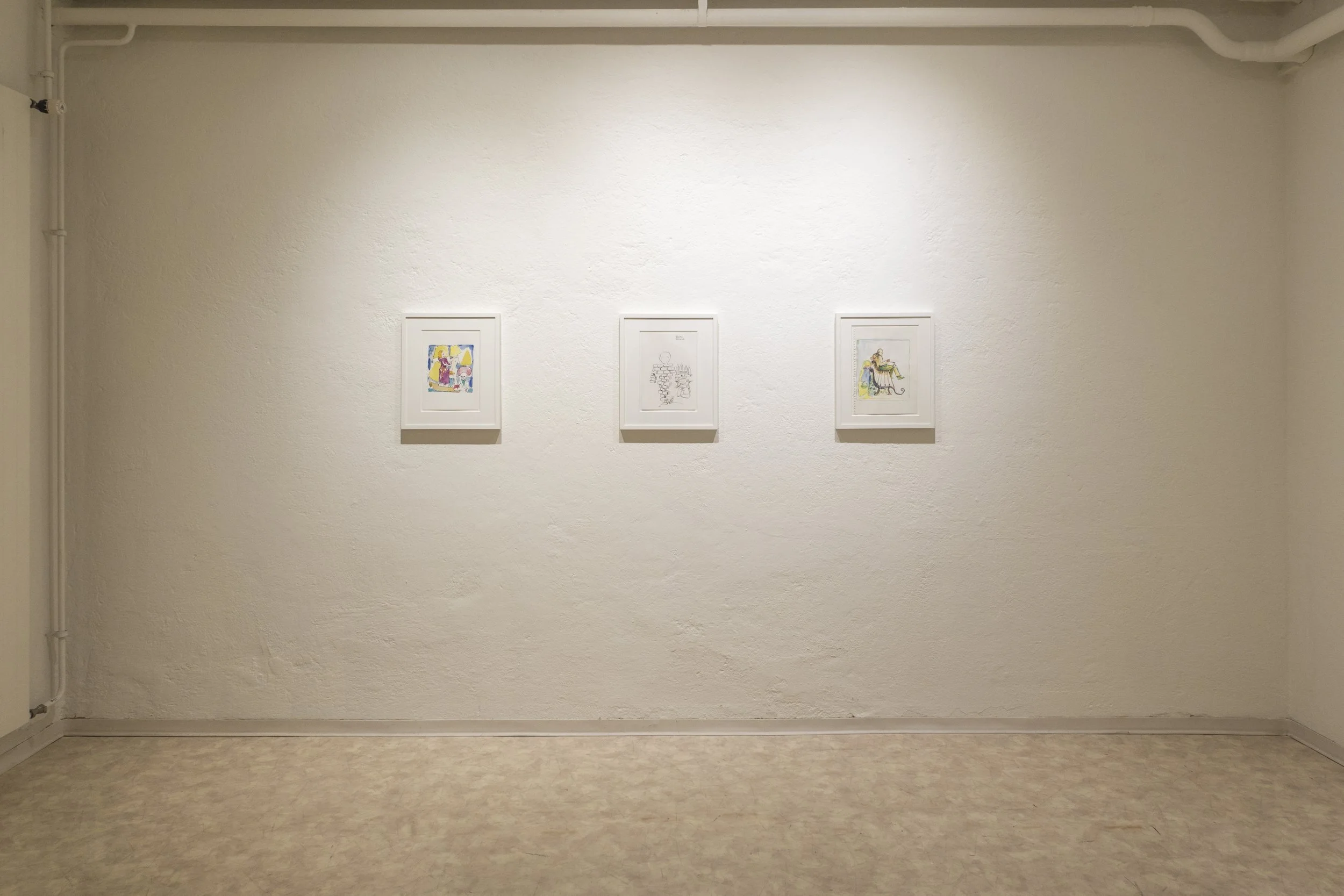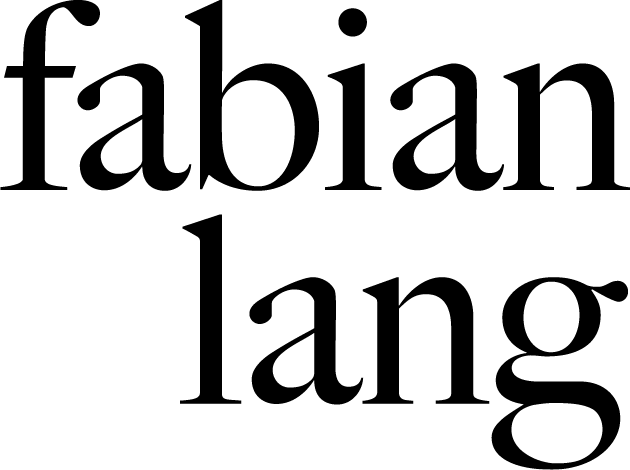COMINGS AND GOINGS
sara anstis and neal tait
20 February - 31 May 2020



















exhibited works: Upstairs
downstairs
PRESS RELEASE (DEUTSCHE VERSION WEITER UNTEN VERFÜGBAR)
[PDF]
Images work where language fails. So much of the world we inhabit defies explication. It is evasive, and our attempts to define it frustrate us. In different ways Sara Anstis and Neal Tait create landscapes and imaginary, otherworldly environments as a means through which to explore subjects too elusive for words alone. Their work playfully explores instincts as diverse as memory, misunderstanding, culture and place.
Anstis uses sensuous soft pastels and paint to build fantasy worlds at a remove from heteronormative patriarchy, yet strikingly transformative of it. The arms of an unknown slick-skinned tentacular creature often appear in her images in this exhibition, either participating in the activities afoot or dividing the image into discrete parts. The Real to which these limbs belong is at once full of pleasure and terror, of tactile excitation and severing frames.
The figures seem to enjoy this creature’s presence and their surroundings, but they also seem to be experiencing events they have no agency over. They do not always smile and when they do, it seems to be in acknowledgment of their wicked and cruel acts - acts that might be acknowledged by the viewer as a pleasurable occurrence in itself. Each tableau is a carefully choreographed scene in which it is not clear who is in control, or who is seeking power over whom, but it is clear that the viewer is not the intended primary witness of their naked bodies or games.
This choreography meets Neal Tait’s play of chance. Diverse in palette and composition, Tait’s paintings and drawings explore tensions between the figurative and the abstract, the beautiful and the grotesque, the logical and the absurd. His recent body of work takes unmediated material - either from his imagination and memory, or from direct observation - as a source, serving as a starting point for intuitive, potentially unexpected compositions led by catching a Zeitgeist.
A work like The Balloon represents the enigmatic moment of sadness that is associated with a fleeting sense of loss. It also depicts a scene of fecundity and regeneration and a time where nature presents itself as something that is truly unknowable. Culture has re-presented nature as a form of nostalgia and we could say that a sense of lost origins has come to define this experience. He doesn’t necessarily intend for the work to provide answers as such, as he says, “I am quite prepared for the work to be wrong and for me to have completely missed the point.”
For him, the language of paint and painting is emphatically of the world, and yet through its history capable of transcending this material state to be, and to comment on a sense of being that exists beyond the unsayable. For both of these artists a re-enchantment of the world is central to understanding their relationship to the present. The outcomes provide glimpses into dreamlike parallel universes that evoke the rhetorical logic of fairy tales or the absurdist humour of Surrealism. Is this not why we remain drawn to paintings with such inevitability? For all of our assuredness and desire to possess the answers to the world’s anomalies, we know that it is actually in those moments where we glimpse the unsayable that we feel truly human.
Pressetext
[PDF]
Bilder wirken oft, wo Sprache versagt. So viel von der Welt, in der wir leben, macht uns verständnislos. Sie entweicht uns und unsere Versuche, sie zu definieren, frustrieren uns. Sara Anstis und Neal Tait schaffen auf eigene Weise Landschaften und imaginäre Jenseitsbereiche, um dadurch Themen zu erforschen, die mit Worten schwer zu fassen sind. Ihre Arbeiten erforschen spielerisch so unterschiedliche Gebiete wie Erinnerung, Missverständnisse, Standort oder Kultur.
Anstis verwendet sinnliche, weiche Pastelle und Farben. Sie schafft damit Fantasiewelten, weg vom heteronormativen Patriarchat und doch auffallend transformativ. Die Arme einer unbekannten glatthäutigen, tentakeligen Kreatur sind in ihren Bildern dieser Ausstellung oft zu sehen. Entweder nehmen sie an den voranschreitenden Aktivitäten teil oder unterteilen das Bild in einzelne Sektionen. Das Reale, zu dem diese Glieder gehören, ist gleichzeitig voller Genuss und Schrecken, taktiler Erregung und trennender Rahmen.
Die Figuren scheinen die Anwesenheit dieser Kreatur und ihrer Umgebung zu geniessen. Gleichzeitig scheinen sie auch Ereignisse zu erleben, auf die sie keinen Einfluss haben. Sie lächeln nicht immer und wenn sie es doch tun, dann anscheinend in Anerkennung ihrer verruchten und grausamen Handlungen - Handlungen, die der Betrachter als angenehmes Ereignis an sich anerkennen könnte. Jedes Tableau ist eine sorgfältig choreografierte Szene, in der nicht klar ist, wer die Kontrolle hat oder wer die Macht über wen begehrt, aber klar ist, dass der Betrachter nicht der vorsätzliche Hauptzeuge ihrer nackten Körper oder Spiele ist.
Diese Choreografie trifft auf das Zufallsspiel von Neal Tait. Taits Bilder und Zeichnungen sind facettenreich in Palette und Komposition und erforschen Spannungen zwischen Figurativem und Abstraktem, Schönem und Groteskem, Logischem und Absurdem. Seine jüngsten Arbeiten basieren auf unvermitteltem Stoff - entweder aus seiner Vorstellungskraft und Erinnerung oder aus direkter Observation - und dienen als Ausgangspunkt für intuitive, möglicherweise unerwartete Kompositionen, die vom Einfangen eines Zeitgeistes geleitet werden.
Eine Arbeit wie The Balloon repräsentiert den enigmatischen Moment der Traurigkeit, der mit einem flüchtigen Gefühl des Verlustes assoziiert ist. Es stellt auch eine Szene der Fruchtbarkeit und Regeneration dar und eine Zeit, in der sich die Natur als etwas präsentiert, das wahrhaftig unverstanden ist. Kultur hat die Natur als eine Form der Nostalgie neu inszeniert, und wir könnten sagen, dass ein Gefühl verlorener Ursprünge diese Erfahrung definiert hat. Tait beabsichtigt nicht unbedingt, dass die Arbeiten Antworten als solche liefern, wie er sagt: "“I am quite prepared for the work to be wrong and for me to have completely missed the point.» (Deutsch: Ich bin darauf vorbereitet, dass die Arbeiten falsch sind und ich das Wesentliche nicht begriffen habe."
Für ihn ist die Sprache von Farbe und Malerei ausdrücklich Teil der Welt, und doch ist sie durch ihre Geschichte in der Lage, diesen materiellen Zustand zu transzendieren und sich über ein Gefühl des Seins, das jenseits des Unsagbaren existiert, zu äussern. Für beide Künstler ist eine Wiederverzauberung der Welt von zentraler Bedeutung, um ihre Beziehung zur Gegenwart zu verstehen. Die Ergebnisse bieten Einblicke in traumähnliche Paralleluniversen, die an die rhetorische Logik von Märchen oder den absurden Humor des Surrealismus erinnern. Bleiben wir deshalb von der Malerei mit einer solchen Unabwendbarkeit angezogen? Trotz all unserer Gewissheit und unserer Sehnsucht, die Antworten auf die Anomalien der Welt zu besitzen, wissen wir, dass wir uns in jenen Momenten wirklich menschlich fühlen, in denen wir das Unsagbare flüchtig zu sehen bekommen.
























